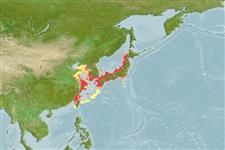Environment: milieu / climate zone / depth range / distribution range
Ökologie
seewasser; süßwasser; brackwasser; amphidrom; tiefenbereich 30 - ? m (Ref. 10943). Temperate; 34°N - 17°S
Northwest Pacific: Yellow Sea, Pohai Sea, Japan Sea, and the Pacific coast of Japan, extending north to Sakhalin and to Preobrazheniye Bight and Vladivostok in the Gulf of Peter the Great. Recorded from the lower part of the Yangtze River in China. Occurrence of this species south to the Ryukyu Islands and Taiwan needs verification.
Length at first maturity / Size / Gewicht / Alter
Maturity: Lm ?, range 17 - ? cm
Max length : 40.0 cm TL Männchen/unbestimmt; (Ref. 637)
Rückenflossenstacheln (insgesamt): 0; Rückenflossenweichstrahlen (insgesamt): 14-18; Afterflossenstacheln 0; Afterflossenweichstrahlen: 15 - 18; Wirbelzahl: 59 - 63. Anterior branch of its preorbital canal curved forward at an angle of about 90°. Predorsal scales 66-81; vertebrae 59-63; pectoral fin rays 12-14, usually 13. Lower jaw shorter than head length.
Common in inshore waters. Occurs in the lower part of the Yangtze River in China (Ref. 10943). Forms small schools and feed mainly on zooplankton. Meat delicious. Also caught with dip nets. Used in Chinese medicine (Ref. 12166).
Life cycle and mating behavior
Geschlechtsreife | Fortpflanzung | Ablaichen | Eier | Fecundity | Larven
Collette, B.B. and J. Su, 1986. The halfbeaks (Pisces, Beloniformes, Hemiramphidae) of the Far East. Proc. Acad. Nat. Sci. Philadelphia 138(1):250-301. (Ref. 10943)
IUCN Rote Liste Status (Ref. 130435)
Bedrohung für Menschen
Harmless
Nutzung durch Menschen
Fischereien: kommerziell
Mehr Information
ReferenzenAquakulturAquakultur ProfilZuchtlinienGenetikElectrophoresesVererbbarkeitKrankheitenVerarbeitungNutrientsMass conversion
PartnerBilderStamps, Coins Misc.LauteCiguateraGeschwindigkeitSchwimmstilKiemenoberflächeOtolithsGehirngrößeSehfähigkeit
Tools
Zusatzinformationen
Download XML
Internet Quellen
Estimates based on models
Preferred temperature (Ref.
123201): 6.9 - 21.7, mean 18.4 °C (based on 8 cells).
Phylogenetic diversity index (Ref.
82804): PD
50 = 0.5000 [Uniqueness, from 0.5 = low to 2.0 = high].
Bayesian length-weight: a=0.00209 (0.00116 - 0.00377), b=3.07 (2.91 - 3.23), in cm total length, based on LWR estimates for this species & Genus-body shape (Ref.
93245).
Trophic level (Ref.
69278): 3.4 ±0.45 se; based on food items.
Widerstandsfähigkeit (Ref.
120179): mittel, Verdopplung der Population dauert 1,4 - 4,4 Jahre. (Assuming tm=2).
Fishing Vulnerability (Ref.
59153): Low to moderate vulnerability (30 of 100).
Climate Vulnerability (Ref.
125649): Very high vulnerability (76 of 100).
Nutrients (Ref.
124155): Calcium = 184 [45, 406] mg/100g; Iron = 0.57 [0.20, 1.52] mg/100g; Protein = 18.2 [15.5, 20.4] %; Omega3 = 0.542 [0.235, 1.493] g/100g; Selenium = 6.23 [2.17, 16.26] μg/100g; VitaminA = 47.2 [10.8, 216.9] μg/100g; Zinc = 0.747 [0.304, 1.983] mg/100g (wet weight);
